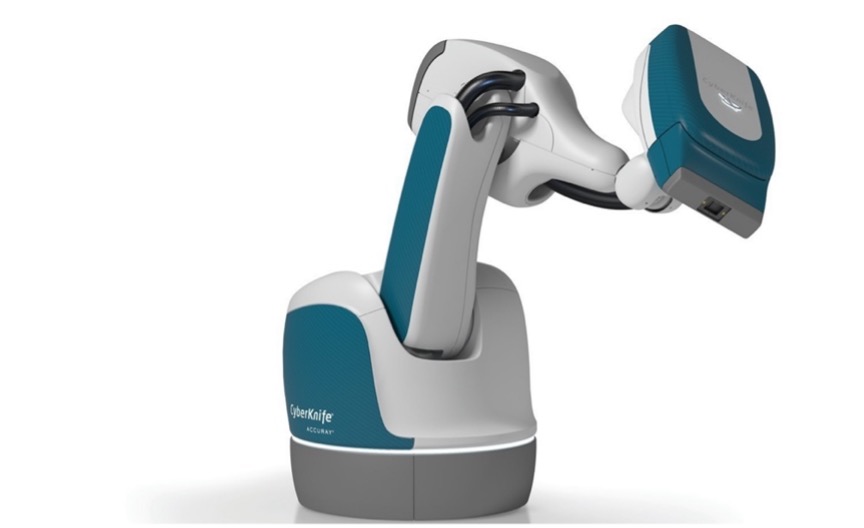
CyberKnife: Cutting-Edge Cancer Treatment Without The Cutting
From its non-invasive approach to its use of robotic technology and artificial intelligence, CyberKnife offers a unique and cutting-edge approach to fighting cancer: painless, non-surgical radiation treatment provided in an outpatient setting.
Invented by Stanford neurosurgeons, CyberKnife earned federal approval for treating diseases around the head and base of the skull in 1999. Two years later, the Food and Drug Administration gave the go-ahead for using CyberKnife against tumors throughout the body. And over the last two decades, CyberKnife has helped thousands of patients around the world, with numerous clinical studies proving its effectiveness.
“The CyberKnife system has continued to evolve since the first patient was treated more than 25 years ago, and it remains the ‘go-to’ device for clinicians who want to confidently deliver precise and accurate stereotactic treatments on a day-in, day-out basis,” Joshua H. Levine, president and CEO of Accuray Inc., the company that developed CyberKnife, said in 2020.
What is CyberKnife and why is it unique?
Featuring the precision of a knife without using an actual blade, CyberKnife delivers targeted radiation with the help of a robotic arm and real-time imaging. Epic Care uses the latest technology, the CyberKnife S7, which offers even more pinpoint treatment and is 95% faster than its predecessor.
Radiation therapy damages cancer cells to prevent them from growing, but traditional approaches to delivering this treatment can involve invasive methods and affect nearby healthy tissue, too. However, using what’s known as stereotactic radiosurgery (SRS), stereotactic body radiation therapy (SBRT) and hypofractionated radiotherapy treatments, CyberKnife offers a more effective treatment than traditional radiation because of its precise delivery of high-level X-ray photons.
Who is eligible for CyberKnife?
If you have cancerous or non-cancerous tumors or need radiation therapy for another condition, you could be eligible for CyberKnife. Those who want to avoid surgery, chemotherapy or more traditional types of radiation treatment also can turn to CyberKnife for help.
Doctors are able to use CyberKnife on any part of your body and for early-stage tumors or more advanced cancers. You also can combine CyberKnife with other cancer treatments, including chemotherapy, surgery, immunotherapy and even conventional radiation. And if you’ve had traditional radiation treatment before, you still may be eligible for CyberKnife.
What to expect with CyberKnife?
Ahead of the procedure, you’ll undergo scans, such as an MRI or PET scan, and the CyberKnife system will then use those results to build a 3-D map of your tumor. Physicians may also implant gold pellets known as fiducials in your body under local anesthesia about one week before the procedure; those will help CyberKnife track the tumor during your treatment.
The day of the procedure, the CyberKnife system will verify your tumor’s location and adjust its positioning accordingly. A linear accelerator – a device that delivers the external beam of radiation – will be mounted on a robot that will move around your body as you lay down.
Thanks to its advanced technology, CyberKnife can adapt to your body’s subtle movements, such as breathing and muscle contractions, that might cause your tumor to shift during the procedure. CyberKnife tracks the location of your cancerous cells and bends around your body, so the radiation beam stays focused on the right spot. The radiation reaches you from thousands of angles and hits its target with a treatment margin of less than a millimeter.
Benefits of CyberKnife
Because of its accuracy, CyberKnife can help patients with surgically complex or inoperable tumors, as well as people with tumors ineligible for traditional radiation, such as those located too close to the brain or spinal cord.
Every patient is different, of course, and Epic Care physicians will take into account several factors, including your age, health, and the type, size and location of the tumor. You’ll typically need to one to five sessions of CyberKnife, which Epic Care performs over one week in its comfortable outpatient treatment center – just one of the many benefits of this treatment.
Usually pain-free, CyberKnife does not require anesthesia. You won’t need body or head frames, rectal balloons or other methods to keep your body stabilized, either, since CyberKnife’s robotic technology adapts to your body. You’ll also get to breathe naturally rather than have to hold your breath like other treatments require.
And thanks to CyberKnife’s accuracy, healthy tissue surrounding the targeted area stays just that: healthy. The smaller treatment margin means less radiation will touch the healthy areas of your body, which decreases your risk of side effects and gives you a better quality of life during and after treatment. Many Epic Care patients experience minimal side effects and usually can go back to their normal lives right away.
A team of experts at Epic Care is ready to help you fight against cancer with this advanced, non-invasive technology. Contact Epic Care today for a consultation or tour to learn more about CyberKnife.








